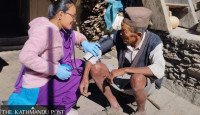Health
Nutrition deficiency still prevalent despite country spending billions to address the issue
Distribution of complementary foods and micronutrients alone will not address the problem, nutritionists say.
Arjun Poudel
Thirty-six percent of Nepali women aged between 15 and 49 years and 49 percent (nearly one in two) children between 6 and 59 months were anaemic in 2006.
The Ministry of Health and Population for years has been distributing iron and folic acid supplementation to women and micronutrient powder to children from state-run health facilities throughout the country to address the issue of anaemia and malnutrition.
However, the Nepal Demographic Health Survey-2016 found that 41 percent of women between the age of 15 and 49 and 53 percent of children between 6 and 59 months were anaemic.
“Despite various efforts made by the authorities, anaemia is still prevalent in the country. The problem seems to be worsening instead,” Dr Aruna Uprety, a public health expert, told the Post. “Billions of rupees are being spent to address the problem but studies show that our efforts are not working at all.”
Between 2006 and 2016, billions of rupees were spent on programmes to tackle the problem of anemia in the country. Such programmes, however, have shown very little or no effect.
The problem of malnutrition has been escalating amidst the ongoing coronavirus pandemic, according to nutritionists. If the report of the Multiple Indicator Survey-2019 is anything to go by, the problem had worsened long before the start of the pandemic.
The report showed that 12 percent of children under five suffer from wasting. Wasting or low weight for a particular height is an undernutrition condition, which is a strong predictor of mortality among children under five, according to the UN health agency. Wasting in children, if not treated properly, is associated with a higher risk of death, according to the report.
Only 10 percent of children under five were suffering from wasting in 2016, according to the Nepal Demographic Health Survey-2016.
The nutrition section at the Family Welfare Division under the Department of Health Services said that the issue of malnutrition has deteriorated throughout the country, especially in the districts of Province 2, amidst the ongoing pandemic.
Besides acute malnutrition cases, moderately acute malnutrition cases are also on the rise in the districts of Province 2.
“To address the moderately acute malnutrition problem, we are procuring super cereal plus, a complementary food to breast milk, worth Rs 100 million,” Kedar Parajuli, chief of the nutrition section, told the Post. “We will be distributing the food in Siraha and Saptari districts.”
The Tarai region, especially the districts of Province 2, is considered the food basket of the country.
Parajuli said that the World Food Programme will be providing technical support to the food distribution project.
Apart from Siraha and Saptari, the Health Ministry has been distributing fortified flour to malnourished children in 22 rural municipalities of Province 2.
Nutritionists say the government has yet to figure out the best way to deal with the existing nutrition problem in the country, which is not declining despite various efforts by the government.
According to them, the government still appears to be reluctant to address the root cause of the problem. They even alleged that government officials find benefit in extending the problem.
“The malnutrition problem should have come under control years ago if the distribution of complementary food or micronutrient powder had worked,” said Uprety. “I don’t think that distributing complementary food will address the issue.”
Due to the Covid-19 pandemic, a lot of people have lost their jobs and their purchasing capacity has declined, factories have shut down, production of food crops has declined and children have been deprived of medical treatment. Daily wage earners and people from lower middle class families have been hit hard by the pandemic.
“Unless authorities concerned promote locally available nutritious foods instead focusing on distributing micronutrient powders, problems of malnutrition will not lessen,” added Uprety.
Doctors say that the pandemic has severely affected the health and mental well-being of the people. But distribution of complementary foods and micronutrients is not the answer to the problem, they say.
“It is impossible to distribute supplementary foods to all malnourished children throughout the country,” Dr Autul Upadhyay, a nutritionist, told the Post. “And it is not the right way to address the problem.”
According to Upadhyay, authorities should promote locally available food products and also take help of the private sector to address the problem.
“Authorities should monitor the quality of food being produced by the private sector and encourage them to produce nutritious foods,” he said. “They should ensure that the products are affordable and nutritious. This will ultimately help in tackling malnutrition in the country.”
According to the Nepal Demographic Health Survey of 2016, 36 percent of children under the age of five years were suffering from chronic malnutrition, while 10 percent suffered from acute malnutrition. Another 27 percent of children were underweight and one percent overweight, the study found.




 10.12°C Kathmandu
10.12°C Kathmandu














